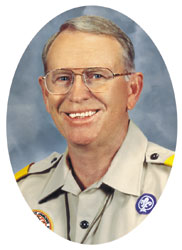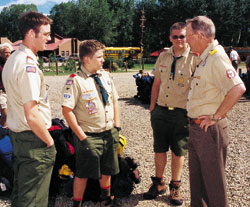![]() October 2000
October 2000


On June 1, Roy L. Williams became Chief Scout Executive of the Boy Scouts of America, following a stint of nearly seven years as director of the BSA's Western Region. Shortly after he began his new duties as the 10th Chief Scout Executive in BSA history, Williams talked with Scouting magazine editor Jon C. Halter about his experiences in Scouting as a youth, his career as a Scouting professional, the importance of volunteer leaders, and his views on current BSA programs and future goals.
How were you active in Scouting as a youth?
I did all of my Scouting with Troop 691 in Oak Cliff, a section of Dallas. When I was 11, some kids at school invited me to a troop meeting. It was a relatively new troop from a working-class neighborhood, chartered to Texas Body Shop, an auto repair business. Mr. Ralph Sawyer—to whom I still talk on occasion—was the Scoutmaster. We had about a dozen boys when I joined, and ended up with 25 or 30.
 In June, Chief Scout Executive Roy Williams served as a trek leader at Philmont. Above, he confers with Grand Canyon Council Scouts Matt Franklin, T. J. Schrock, and his son, Andrew, before hitting the trail. |
Are there any special moments as a Boy Scout that you remember?
Once, on a camp-out at a small farm, Mr. Sawyer was standing by a ravine about 8 to 10 feet deep. "I wonder if you guys could build a monkey bridge across this," he said. "In Boys' Life magazine I saw an article on how to use a cardboard box and clothes hangers to make rope. So why don't we start making rope and see if we can do this?"
At every troop meeting for the next several months, we had kids in the back of the room making rope and splicing it. And five months later, we built a monkey bridge across the ravine.
We had great group pride in that accomplishment, because we had made our own rope, even if it wasn't the greatest quality. That was one of a number of lessons I've learned over the years working with people: If you can plant an idea, then with a little bit of watering t he seed, people will take off and run with it and get a lot out of it. But somebody's got to be planting those good ideas—and that's what leadership is all about.
At what point in your life did you decide to go into professional Scouting?
When I got out of the Air Force, I was able to enroll in college with about 40 hours of credit already earned as a result of taking college courses at night. I was a senior in college when I married Barbara, who had already graduated and was looking for a teaching job. She came home from the college placement office one day and said, "You've always said that you had a very good experience in Scouting and if we ever got settled, you'd like to become involved again."
I was working two part-time jobs and going to school full time, so I reminded her that I had no time left for any volunteer work. She said, "No, I think this is a paid position."
So I called the Longhorn Council in Fort Worth and arranged for an interview. They hired me, and Barbara and I moved 100 miles out to Graham, in west Texas, where I started as a district executive.
What do you tell young people about professional Scouting as a career?
If you have any sense of mission, if you have a part of your heart that really wants to make a contribution, then it's the right kind of work for you. And there's a certain amount of sacrifice you have to be willing to accept and embrace.
The great reward [in this profession] is all the volunteers you meet and get to know [and] who will make you a better person because they are the type of people you will work with for the rest of your life. People who are caring, giving individuals, who are trying to raise a family, have some responsibility at church, and are involved with community groups.
In addition to your professional career, you've also been involved as a volunteer leader.
Not as much as I'd like to be. I go to my son's troop meetings and on camp-outs when I can, and this past summer I had the opportunity to serve as a leader when Scouts from the troop went to Philmont Scout Ranch as members of the Grand Canyon Council contingent. I had made this commitment before I was named Chief Scout Executive, and I was really looking forward to it.
Ben Love and Jere Ratcliffe, the two men who preceded you as Chief Scout Executive, introduced new programs and strategies that extended Scouting's impact on society while remaining true to our traditional values. Generally speaking, in the next few years, in what areas do you see a need for special focus and emphasis?
The critical issues defined in the National Strategic Plan 1998-2002 are still a priority. I told [then-BSA National Vice President] Roy Roberts and the selection committee and Milton Ward, our new national president, that we needed to do a better job reaching out to kids who grow up in modest circumstances, in rural and urban areas, who will get the most benefit from our values-based programs.
We're going to continue to concentrate on our traditional programs because they give us license to go out and do a lot of other things in the community through our Learning for Life programs.
We're going to do our best to try to keep all of our councils financially strong. We'll continue to focus efforts to make sure the Boy Scouts of America has the resources of its own to continue the program. If you don't have this financial strength to withstand challenges, you can be blown in a lot of directions, and off course. So, the endowment funds for local councils will continue to be a major emphasis.
The BSA national annual meeting in Nashville highlighted efforts to promote the concept of a "seamless" Scouting program, with a built-in transition from Cub Scouts to Webelos Scouts to Boy Scouting to Venturing. How do you see that evolving?
The goal is for the different programs to work closely together so that each program leads a child to the next level.
During the years I served as director of the Boy Scout Division at the national office, we determined that a key problem in the Webelos-to-Scout transition was that younger boys can be intimidated by older Scouts in the troop. Our challenge was to figure how to get children of different ages to work together, while continuing to develop ways to help a boy grow with age-appropriate activities.
It's not the easiest task. A 10-year-old and a 13-year-old have many more differences than just three years of age. So we introduced the new-Scout patrol concept, with an older boy, called a troop guide, working both as a buffer and a mentor, so the new Scouts would not be intimidated.
Units now wait several years before a high adventure trek is available at Philmont. Should more use be made of council high adventure programs as alternatives?
Philmont is a great treasure, which is why so many people want to experience it. However, many local councils do have wonderful high adventure opportunities. And a great tool to help unit leaders take advantage of them is the booklet Passport to High Adventure [BSA Supply No. 4310], which includes a directory of council high adventure programs. Many troops also use the Internet to research council programs, and we're going to see more use of these opportunities, especially by troops looking for challenging experiences for older boys.
New BSA President Milton Ward has called for a special focus on the Unit Growth Emphasis program and the goal of putting a Scout unit in every community in America. Are there any new strategies for accomplishing this goal?
That's a part of our traditional program focus. People are going to hear a lot about putting a map in a council service center and putting pins in that map so that when everyone in the council walks by, they can see—volunteers and staff—where we've got active units and where we don't. And we're going to try to focus the energy of both professional staff and volunteers on this goal.
In what ways can volunteers contribute to this effort?
Volunteers are our greatest asset, and Scouting could not exist without them. The partnership between volunteers and professional staff is the core of our success. Volunteers have the best connections. They know the pastors. They know the neighborhood. And they know who are the best people to be working with children. The strongest new units are those organized by volunteer membership committees, with support from district training committees and commissioner staffs.
Volunteer training, including Wood Badge, is undergoing a revision. What is the direction of these changes?
The direction is that, for the person who comes in to one program, training will be an enhancement of what they've had in the previous program. In my opinion, the key point in training is to help people [know] where to go for help, so they know what the resources are, get enthused about what they're doing, meet other people who are enthused about what they're doing, and meet some trainers who are a phone call away.
An effective training course, whether it's Wood Badge or basic training, will have good, enthusiastic people working together to transmit information and convey enthusiasm. And we have a lot of enthusiastic committee members and Wood Badge staff who will continue to do that.
What are your thoughts on the importance of the uniform in Scouting?
Well, certainly I would like to see every Scout correctly uniformed, because it is one of the methods of the Scouting program and serves many purposes. I would hope that leaders would take the time to see how uniforms should be worn; and if they're a uniform-type volunteer, like Scoutmaster, assistant Scoutmaster, den leader, or Cubmaster, that they would not do it halfway—and that their uniforms are neat and clean and setting a good example.
In closing, is there anything else you would like to tell the readers of Scouting magazine?
That I am very honored to serve as the Chief. One of the things I did in that capacity this summer was to address more than 7,000 boys and leaders at the National Order of the Arrow Conference. It was a terrific experience and allowed me to speak directly to thousands of young people about the virtues of what a Scout should be and to encourage them to live the life of a Scout. That is our responsibility as adults in Scouting, and I hope to keep us focused on that task.
Copyright © 2000 by the Boy Scouts of America. All rights thereunder reserved; anything appearing in Scouting magazine or on its Web site may not be reprinted either wholly or in part without written permission. Because of freedom given authors, opinions may not reflect official concurrence.
| The Boy Scouts of America | http://www.scouting.org |